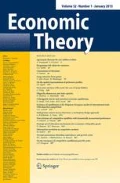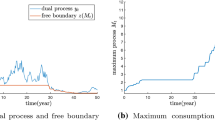Summary
We develop a duality approach to study an individual's optimal consumption and portfolio policy when the individual has limited opportunities to borrow against future labor income and cannot totally insure the risk of income fluctuations. The individual's intertemporal consumption and portfolio problem is cast in a continuous-time setting under uncertainty. We transform the individual's intertemporal problem into a dual shadow prices problem that solves the shadow prices for the individual's optimal consumption plan or equivalently the individual's intertemporal marginal rates of substitution. We show that the shadow prices process can be expressed as a product of a martingale and a decreasing process (normalized by the bond price). The existence of an optimal solution to the individual's intertemporal consumption and portfolio problem is established via duality. The duality approach also allows us to characterize in a sample way the individual's optimal consumption and portfolio policy in the presence of labor income and borrowing constraints. Equilibrium implications of borrowing constraints on asset prices are also discussed in the paper.
Similar content being viewed by others
References
Back, K.: Asset pricing for general processes. J. Math. Econ.20, 371–396 (1991)
Balakrishman, A. V.: Applied functional analysis. Berlin: Springer-Verlag 1981
Bardhan, I.: Constrained Consumption Policies in an Incomplete Market. Working paper, Department of Industrial Engineering and Operations Research, Columbia University 1991
Bewley, T.: The permanent income hypothesis: A theoretical formulation. J. Econ. Theory16, 252–292 (1977)
Breeden, D. T.: An intertemporal asset pricing model with stochastic consumption and investment opportunities. J. Financ. Econ.7, 265–296 (1979)
Brown, D. P.: The implications of nonmarketable income for consumption based modes of asset pricing. J. Finance43, 867–880 (1988)
Cox, J. C., Huang, C.-f.: Optimal consumption and portfolio policies when asset prices follow a diffusion process. J. Econ. Theory49, 33–83 (1989)
Cox, J. C., Ingersoll, J. E., Ross, S. A.: An intertemporal general equilibrium model of asset prices. Econometrica53, 363–384 (1985)
Cvitanić, J., Karatzas, I.: Convex duality in constrained portfolio optimization. Working paper, Department of Statistics, Columbia University 1991
Davis, M. H. A., Norman, A. R.: Portfolio selection with transaction costs. Math. Operat. Res.15, 676–713 (1990)
Duffie, D., Fleming, W., Zariphopoulou, T.: Hedging in incomplete markets with HARA utility. Working paper, Graduate School of Business, Stanford University 1991
Duffie, D., Huang, C.: Implementing Arrow—Debreu equilibria by continuous trading of few long-lived securities. Econometria53, 1337–1356 (1985)
Duffie, D.: Stochastic equilibria: Existence, spanning number, and the ‘no expected gain from trade’ hypothesis. Econometrica54, 1161–1184 (1986)
Dellacherie, C., Meyer, P.-A.: Probabilities and potential B: Theory of Martingales. New York: North-Holland 1982
Dunford, N. H., Schwartz, J. T.: Linear operators. New York: Interscience 1958
Fleming, W. H., Rishel, R. W.: Deterministic and stochastic optimal control. Berlin: Springer-Verlag 1975
Grossman, S. J., Shiller, R. J.: Consumption correlatedness and risk measurement in economies with non-traded assets and heterogenous information. J. Financ. Econ.10, 195–210 (1982)
Hansen, L. P., Singleton, K. J.: Generalized instrumental variables estimation of rational expectations models. Econometrica50, 1269–1286 (1982)
Harrison, J. M., Kreps, D. M.: Martingales and multiperiod securities markets. J. Econ. Theory.20, 381–408 (1979)
He, H., Modest, D. M.: Market frictions and consumption-based asset pricing. Working paper, Haas School of Business, UC Berkeley, 1992
He, H., Pearson, N. D.: Consumption and portfolio polices with incomplete markets and short-sale constraints: the finite dimensional case. Math. Finance1, 1–10 (1991a)
He, H., Pearson, N. D.: Consumption and portfolio policies with incomplete markets and short-sale constraints: The infinite dimensional case. J. Econ. Theory.54, 259–304 (1991b)
Hellwig, M.: Precautionary money holding and the payment of interest on money. Discussion paper, University of Bonn, Germany 1982
Huang, C.: An intertemporal general equilibrium securities pricing model: The case of diffusion information. Econometrica55, 117–142 (1987)
Karatzas, I.: On the pricing of American options. Applied Math. Optim.17, 37–60 (1988)
Karatzas, I., Lehockzy, J. P., Shreve, S. E., Xu, G. L.: Martingale and duality methods for utility maximization in an incomplete market. SIAM J. Control Optim.29, 702–730 (1991)
Koo, H. K.: Consumption and portfolio choice with uninsurable income risk. Working paper, Department of Economics, Princeton University 1991
Leland, H. E.: Saving and uncertainty: The precautionary demand for saving. Q. J. Econ.82, 465–473 (1968)
Luenberger, D. G.: Optimization by vector space methods. New York: John Wiley & Sons 1969
Mariger, R. P.: A life-cycle consumption model with liquidity constraints: Theory and empirical results. Econometrica55, 533–557 (1987)
Merton, R. C.: Optimum consumption and portfolio rules in a continuous time model. J. Econ. Theory.3, 373–413 (1971)
Merton, R. C.: An intertemporal capital asset pricing model. Econometrica41, 867–887 (1973)
Miller, B. L.: Optimal consumption with a stochastic income stream. Econometrica42, 253–266 (1974)
Pagès, H,: Optimal consumption and portfolio policies when markets are incomplete. Working paper, Sloan School of Management, MIT, 1987
Rockafellar, R. T.: Integral functionals, normal integrands, and measurable selections. In: Gossez, J. et al. (eds.) Nonlinear operators and the calculus of variations. New York: Springer-Verlag, 1975
Schechtman, J.: An income fluctuation problem. J. Econ. Theory12, 218–241 (1976)
Scheinkman, J. A., Weiss, L.: Borrowing constraints and aggregate economic activity. Econometrica,54, 23–45 (1986)
Sheshinski, E.: A simple model of optimum life-cycle consumption with earnings uncertainty. J. Econ. Theory49, 169–178 (1989)
Svensson, L. E. O., Werner, I.: Nontraded assets in incomplete markets: pricing and portfolio choice. Working paper, Graduate School of Business, Stanford University 1990
Zeldes, S. P.: Consumption and liquidity constraints: An empirical investigation. J. Polit. Econ.97, 305–346 (1989)
Author information
Authors and Affiliations
Additional information
This is a revised version of an earlier paper, entitled “Consumption and Portfolio Decisions with Labor Income and Borrowing Constraints”. We thank George Constandinides, Ayman Hindy, and Chi-fu Huang for helpful comments. We also thank two anonymous referees for their helpful comments and suggestions. Financial support from the Batterymarch Fellowship Program (for Hua He) is gratefully acknowledged.
Rights and permissions
About this article
Cite this article
He, H., Pagès, H.F. Labor income, borrowing constraints, and equilibrium asset prices. Econ Theory 3, 663–696 (1993). https://doi.org/10.1007/BF01210265
Received:
Revised:
Issue Date:
DOI: https://doi.org/10.1007/BF01210265




